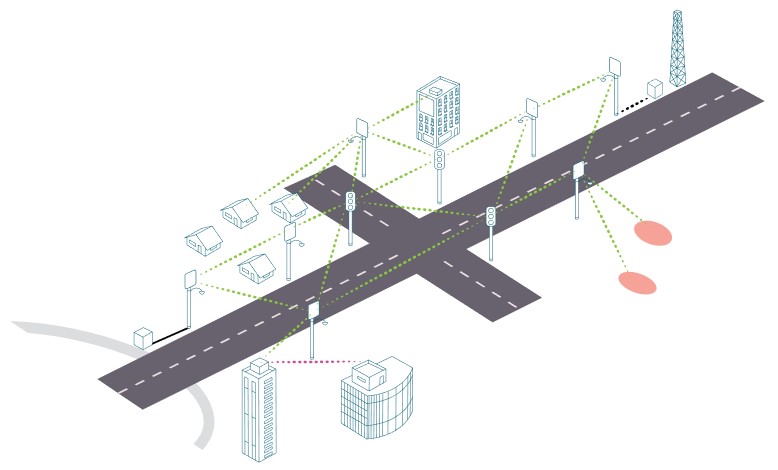Multi-Gigabit Edge Capacity to Meet Demand
Millimeter wave fixed wireless technology enables service providers and enterprise network operators to extend their network with multi-gigabit speeds in urban, suburban and rural locations.
Wi-Fi deployments require higher WAN capacity, forcing convergence of the WAN and LAN. Millimeter wave technology offers multi-gigabit speeds in multiple configurations for last-mile access and backhaul for Wi-Fi hotspots or MicroPoP access. A multi-mode system can be configured for Point-to-Point (PTP), Point-to-Multipoint (PMP), or efficient mesh modes. Certified for highly efficient Facebook Terragraph distributed mesh technology, 60 GHz solutions make it easy to provide efficient multi-gigabit speeds in the heart of any city.
Learn more about Fixed 5G by watching this webinar.
The City of San José deploys cnWave gigabit fixed wireless infrastructure for municipal Wi-Fi in the downtown area. Get the details here.
Pentanet Deploys 60 GHz cnWave to Offer Gigabit Speeds in Perth, Australia
“We applaud Cambium Networks for their technological innovation, helping to deploy multi-gigabit connectivity worldwide with their latest 60 GHz cnWave solution. These field installations of 60 GHz by service providers are a great validation of the opportunity 60 GHz mmWave Fixed Wireless yields and of Cambium’s cnWave product, utilizing Qualcomm Technologies’ 60 GHz solutions.”
– Rahul Patel, senior vice president and general manager, connectivity at Qualcomm Technologies, Inc.
V5000
Distribution Node
Product Page
V3000
High Gain Client Node
Product Page
V1000
Client Node
Product Page
Applications
Multi-gigabit wireless communications at the edge of the network provide high-speed access to bridge the digital divide in the following applications:

The 802.11ay Standard
TDMA/TDD vs CSMA
802.11ay is based on TDMA/TDD channel access with network synchronization. This technology is preferred for outdoor fixed wireless applications because the synchronized system reduces interface and maximizes frequency reuse.
Support for More CPE
The 802.11ad standard supports 8 Client Nodes per sector, while 802.11ay supports 15 Client Nodes per sector. As a result, the solution opens more opportunities for business cases and deployment strategies.
Support for Mesh Architectures
The 802.11ay standard also supports meshing technology to provide a highly reliable and flexible Layer 3 architecture to facilitate network design and deployment.
Channel Bonding Technology
Effectively Doubling Throughput With Channel Bonding
Channel Bonding allows two contiguous channels to be merged into a single wideband channel, thereby doubling the capacity to 4.32 Gbps. 802.11ad does not support Channel Bonding and is limited to a single radio. Hence 802.11ay will always outperform 802.11ad.
60 GHz cnWave – Multigigabit Wireless Technology
Products
V5000 Distribution Node
V3000 Client Node
V1000 Client Node
Planning Software
cnHeat RF prediction heatmapping
LINKPlanner deployment modeling
Centralized Cloud Management
cnMaestro monitoring and management system
In the News
Alaska Communications Delivers Gigabit Speed Service with Fixed Wireless Access Technology from Cambium Networks
Senza Fili consulting report: Cambium Networks: Wireless gigabit connectivity with 60 GHz Terragraph
Details on Rural Digital Opportunity Funds (RDOF) Resources
Blog: Multi-Gigabit Fixed Wireless Connects Your World
Blog: Strength Through Wireless Diversity
Solution Papers
802.11ay Emerges as the New Standard for 60 GHz Wi-Fi
Webinars
cnWave: Delivering Gbps Services with Distributed Mesh Networking
How to use Advanced Network Planning (ANP) tool to optimize 60 GHz cnWave performance when using Terragraph mesh technology
60 GHz cnWave Solutions for Service Providers
60 GHz webinar with Facebook Connectivity
LINKPlanner V5.4.3: 60 GHz cnWave Project Planning
Advanced Network Planning (ANP) for 60 GHz cnWave Deployments
How to Plan a 60 GHz cnWave Network
Building the Business Case for Wireless Backhaul for Public Wi Fi (Session 1)
Building the Business Case for Fixed Wireless in Urban Settings (Session 2)
Discuss 60 GHz on the Cambium Networks Community